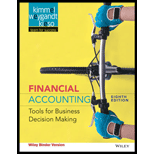
Financial Accounting 8th Edition
8th Edition
ISBN: 9781119210818
Author: Kimmel, Weygandt, Kieso
Publisher: WILEY
expand_more
expand_more
format_list_bulleted
Question
Chapter 13, Problem 13.7E
To determine
Current Ratio : Current ratio is used to determine the relationship between current assets and current liabilities. The ideal current ratio is 2:1
Formula:
Accounts receivable ratio: This ratio is mainly used to evaluate the collection process efficiency. It helps the company to know the number of times the accounts receivable is collected in a particular time period. Main purpose of accounts receivable turnover ratio is to manage theworking capital of the company.
Formula:
- Average collection period: Average collection period is used to determine the number of days a particular company takes to collect accounts receivables.
Formula:
- Inventory turnover ratio: Inventory turnover ratio is used to determine the number of times inventory used or sold during the particular accounting period.
Formula:
- Days’ sales in inventory: Days’ sales in inventory are used to determine number of days a particular company takes to make sales of the inventory available with them.
Formula:
To compute: Liquidity ratios
Given info: Items of current assets and current liabilities
Expert Solution & Answer
Want to see the full answer?
Check out a sample textbook solution
Students have asked these similar questions
Hi expert please help me this question final answer
Can you help me solve this general accounting question using valid accounting techniques?
General accounting
Chapter 13 Solutions
Financial Accounting 8th Edition
Ch. 13 - Prob. 1QCh. 13 - Prob. 2QCh. 13 - Prob. 3QCh. 13 - Prob. 4QCh. 13 - Prob. 5QCh. 13 - Prob. 6QCh. 13 - Prob. 7QCh. 13 - Prob. 8QCh. 13 - Prob. 9QCh. 13 - (a) Distinguish among the following bases of...
Ch. 13 - Prob. 11QCh. 13 - Prob. 12QCh. 13 - Prob. 13QCh. 13 - Prob. 14QCh. 13 - Prob. 15QCh. 13 - Prob. 16QCh. 13 - Prob. 17QCh. 13 - Prob. 18QCh. 13 - Prob. 19QCh. 13 - Prob. 20QCh. 13 - Prob. 21QCh. 13 - Prob. 22QCh. 13 - Prob. 13.1BECh. 13 - Prob. 13.2BECh. 13 - Prob. 13.3BECh. 13 - Prob. 13.4BECh. 13 - Prob. 13.5BECh. 13 - Prob. 13.6BECh. 13 - Prob. 13.7BECh. 13 - Prob. 13.8BECh. 13 - Prob. 13.9BECh. 13 - Prob. 13.10BECh. 13 - Prob. 13.11BECh. 13 - Prob. 13.12BECh. 13 - Prob. 13.13BECh. 13 - Prob. 13.14BECh. 13 - Prob. 13.15BECh. 13 - Prob. 13.1DIECh. 13 - Prob. 13.2DIECh. 13 - Prob. 13.3DIECh. 13 - Prob. 13.1ECh. 13 - Prob. 13.2ECh. 13 - Prob. 13.3ECh. 13 - Prob. 13.4ECh. 13 - Prob. 13.5ECh. 13 - Prob. 13.6ECh. 13 - Prob. 13.7ECh. 13 - Prob. 13.8ECh. 13 - Prob. 13.9ECh. 13 - Prob. 13.10ECh. 13 - Prob. 13.11ECh. 13 - Prob. 13.12ECh. 13 - Prob. 13.13ECh. 13 - Prob. 13.1APCh. 13 - Prob. 13.2APCh. 13 - Prob. 13.3APCh. 13 - Prob. 13.4APCh. 13 - Prob. 13.5APCh. 13 - Prob. 13.1EYCTCh. 13 - Prob. 13.2EYCTCh. 13 - Prob. 13.3EYCTCh. 13 - Prob. 13.4EYCTCh. 13 - Prob. 13.7EYCTCh. 13 - Prob. 13.8EYCTCh. 13 - Prob. 13.9EYCTCh. 13 - Prob. 13.1IFRS
Knowledge Booster
Similar questions
- TechNova Inc. is starting a new project expected to generate $1,200,000 in revenues, $400,000 in cash operating expenses, and depreciation expense of $200,000 per year for 8 years. The corporate tax rate is 30%. The project will require an increase in net working capital of $100,000 in year one and a decrease in net working capital of $90,000 in year eight. What is the free cash flow from the project in year one? A) $520,000 B) $530,000 C) $540,000 D) $550,000arrow_forwardDon't use ai given answer and general accountingarrow_forwardProvide correct optionarrow_forward
arrow_back_ios
SEE MORE QUESTIONS
arrow_forward_ios
Recommended textbooks for you
 Managerial Accounting: The Cornerstone of Busines...AccountingISBN:9781337115773Author:Maryanne M. Mowen, Don R. Hansen, Dan L. HeitgerPublisher:Cengage LearningPrinciples of Accounting Volume 1AccountingISBN:9781947172685Author:OpenStaxPublisher:OpenStax College
Managerial Accounting: The Cornerstone of Busines...AccountingISBN:9781337115773Author:Maryanne M. Mowen, Don R. Hansen, Dan L. HeitgerPublisher:Cengage LearningPrinciples of Accounting Volume 1AccountingISBN:9781947172685Author:OpenStaxPublisher:OpenStax College

Managerial Accounting: The Cornerstone of Busines...
Accounting
ISBN:9781337115773
Author:Maryanne M. Mowen, Don R. Hansen, Dan L. Heitger
Publisher:Cengage Learning

Principles of Accounting Volume 1
Accounting
ISBN:9781947172685
Author:OpenStax
Publisher:OpenStax College